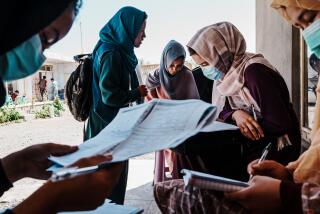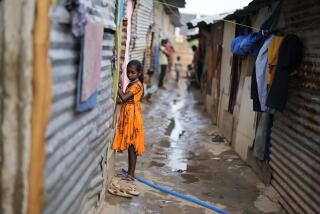In Squalid Slum, They’re Permanently Temporary : Tibetan Refugees Look Homeward From India
- Share via
NEW DELHI — Tibetan refugees live here in a muddy, pestilential slum that is squalid even by Indian standards. Tuberculosis and malaria are rampant.
Tattered Tibetan flags fly above temporary roofs covered with plastic sheets. The roofs have been temporary for more than 20 years, ever since the Tibetans fled Chinese rule in their homeland.
Like people in refugee camps elsewhere, the Tibetans have become permanently temporary.
At the settlement of Majnu Ka Tilla, on the banks of the Jumna River, the main industry is producing a sour, milky-white, barley beer called chaang and selling it for 3 1/2 rupees a quart (30 cents) to bicycle rickshaw drivers and slumming students from Delhi University.
Some of the Tibetans’ neighbors mock them and make fun of their trade. “Chaangistan,” they call the Tibetan settlement, or “Chaangapuri”--Beertown.
In the dozens of bars, under posters of the Dalai Lama, Jesus and the late martial-arts star Bruce Lee, the drinking begins in the morning. By early afternoon, drunks are asleep on tables or lurching and retching in the fetid alleys.
The settlement at Majnu Ka Tilla is the lowest level for the 100,000 or so Tibetan refugees in India, most of whom came here after their god-king, the Dalai Lama, fled from Chinese authorities in 1959 after an abortive rebellion in Lhasa, the Tibetan capital.
On Sept. 1, almost 35 years after the Chinese invaded and established military control over Tibet, Tibet will observe its 20th anniversary as an “autonomous region” of the People’s Republic of China.
To mark the anniversary, the Chinese have spent an estimated $140 million on 43 improvement projects, including two large tourist hotels in Lhasa. The Chinese apparently feel secure enough in their rule to promote overland tourism from Katmandu in neighboring Nepal.
But this week, it was disclosed that the Chinese have banned journalists and official foreign observers from the Sept. 1 celebration and indicated that the ban on journalists may be permanent. Apparently, there is concern that foreign officials may observe demonstrations in favor of Tibetan independence from China.
Taking a cue from their leader, the Dalai Lama, who lives most of the year in a large Lamaistic Buddhist colony in the Indian hill station of Dharmsala, Tibetan refugees here had hoped that foreign reporters would continue to bring back tales of woe from their homeland and build worldwide sympathy for their cause.
They were delighted by reports that came out of Tibet before the ban was imposed. Among other things, the stories have portrayed the Tibetans’ still-passionate devotion to the Dalai Lama. Visitors are constantly pestered for recent pictures of the kindly, stoop-shouldered Dalai Lama.
“We have information . . . that things are not so rosy in Tibet,” said the Dalai Lama, whose title means “ocean of wisdom” and whose own name is Tenzin Gyatso. Now 51, he has been Tibet’s spiritual leader since he was 15, but more than two-thirds of his life has been spent in India.
The Chinese have invited him to return but he has refused, saying the time was not ripe. He is convinced that the people of Tibet are suffering in his absence. In his booming voice, he said in English that “95% of the people are unsatisfied. There is no freedom in any form there.”
Namgyal Gorjee Teykhang, the Dalai Lama’s chief representative in the northernmost Indian state of Ladakh, said that, since 1959, “our main hope has been to get independence for Tibet.”
There are 5,000 Tibetan refugees in Ladakh, and they live in conditions much better than those at the Majnu Ka Tilla settlement in New Delhi. The European-financed Tibetan refugee school at Leh, the capital of Ladakh, is heated and lighted with solar power. The students are instructed in Tibetan, Hindi and English.
An estimated 3 million people live in Tibet under Chinese rule. The relatively small number of refugees--less than one-thirtieth of Tibet’s population--effectively inhibits any armed action against the Chinese from the outside. By comparison, more than one-fifth of the Afghan people are abroad as a result of the 1979 Soviet invasion.
Also, U.S. interest in stirring up pro-Dalai Lama forces inside Tibet seems to have faded as U.S. relations with China have improved.
An American-sponsored rebel base on the southern border with Nepal was closed in 1974. Nepal apparently no longer fears Chinese aggression.
“We have stopped guerrilla warfare because the Americans closed their base,” said Kalsang K. Wangchuck, welfare director of the refugee settlement here. “Also, the Nepalese and the Chinese have become very close friends, and the Indian government and the U.S. have become distant.”
As the years go by, the chances for the return of the Dalai Lama and his followers become increasingly slight. In refugee camps, children have been born to parents who were born in India. The children, raised in the searing heat of New Delhi or the jungles of Orissa, where another Tibetan refugee camp is situated, have only a vague appreciation of their ancestral homeland. Many have never seen a yak, the Tibetan beast of burden and the source of butter and cooking fuel there.
Kelsang Tashi, 15, a student at the Majnu Ka Tilla settlement, who speaks Hindi and English, was asked to describe Tibet, and replied: “Tibet is a happy place with a lot of mountains, hills and animals.”
Tsering Wangmo, also 15, said: “There are no poor people in Tibet. Everyone is happy and rich.”
For the new generation of Tibet an refugee children, Tibet has become the same distant, mystical place it is for many foreigners. Perhaps they see it as a release from their slum homes in India, but the Dalai Lama insists that Tibetan culture is preserved in India.
“Up to now,” he said, “being outside Tibet has helped. At least on this planet there are pure Tibetan civilizations which, unfortunately, in our own country have disappeared.”
Earlier this year the Dalai Lama turned down a Chinese invitation to visit Lhasa, though he had said earlier that he would visit Tibet in the course of 1985.
According to the Dalai Lama’s chief representative in New Delhi, Tashi Wangdu, a refugee educated at an English university, the plan to visit Tibet was abandoned after a crackdown on the Dalai Lama’s supporters inside Tibet.
Meanwhile, at the Majnu Ka Tilla school here in New Delhi, schoolmaster D.S. Singh has begun holding the Tibetan students in class until late in the evening to keep them away from the drunks and violence at the parlors that serve the beer called chaang.
“Our main aim is to keep them here until at least 8:30 at night, when the chaang business ceases,” Singh said. “Such atmosphere affects the minds of the students.”
So the children are fed and given instruction in the Tibetan language, preparing them for a trip home they may never make.
More to Read
Sign up for Essential California
The most important California stories and recommendations in your inbox every morning.
You may occasionally receive promotional content from the Los Angeles Times.













